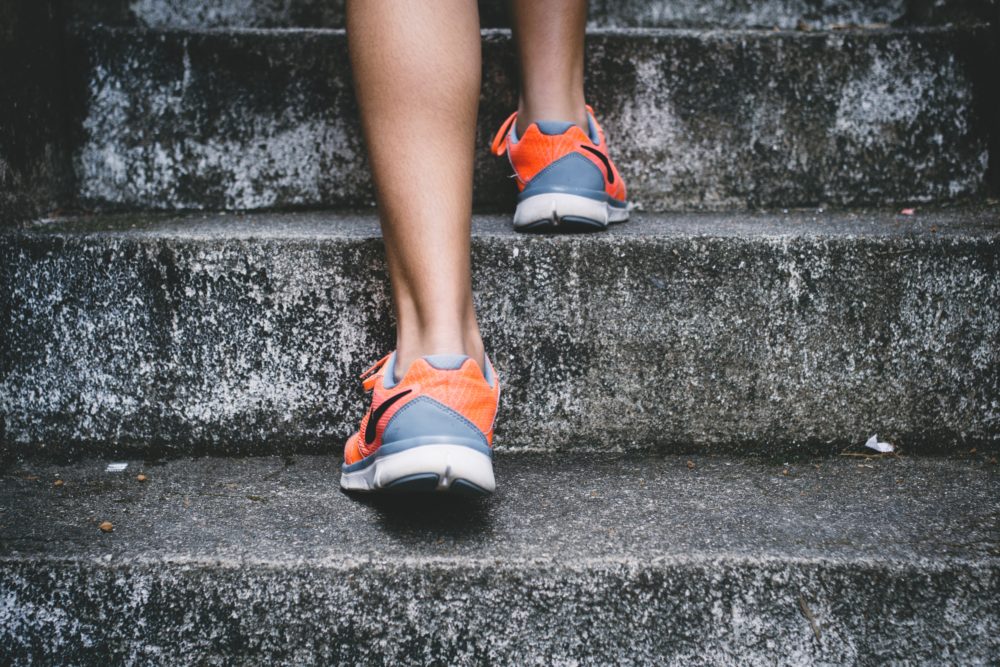This article was previously published on May 11, 2017.

Humans have seen a multitude of fitness trends since we first began to realize we could modify our bodies thousands of years ago. From body building to aerobics to HIIT to low-impact activity, just about everything under the sun has been hyped at one point or another.
And now, as some camps fall prey to the claims of super intense fitness regimes filled with endless burpees and uphill sprints, others are deciding that all you need is a bit of walking to stay fit and healthy–no gym membership or expensive classes required.
10,000 steps (roughly 5 miles of movement) a day is the roundabout goal that most health literature recommends, as suggested by a man named Y. Hatano in 1965. It was during this time that Hatano had built a pedometer to measure one’s progress towards this goal; he theorized that 10,000 steps was the ideal amount to offset any “excess” caloric intake and keep one’s weight in check.
Although this concept is merely a hypothesis, it has since been backed by The World Health Organization, American Heart Association, and various academic journals. It was taught to me in my college fitness class (minus the historical context). And now, more and more health-conscious people are jumping on board, but of course. Because doesn’t it sound more fun to lead a naturally active lifestyle than spend 30 minutes on a treadmill surrounded by a sweaty mass of fitness junkies?
Apparently, the 10,000 step rule doesn’t require you to get your heart rate up or break a sweat–no running or step-climbing required. Just walk a bit, and it will benefit your health enough to skip the backbreaking workouts.
(And let’s remember that size does not equate to health–you can be larger bodied and perfectly healthy by medical standards.)
That being said, a recent study by the International Journal of Obesity argued that if 10,000 steps is good, 15,000 is better, and more effectively lowers waist circumference/ cardiovascular risk.
If changing your weight or body shape is the end goal, you may want to increase your step goal a bit. But you could also keep it as is and complement it with a bit of extra (or amplified) movement. Work some sprints or body weight exercises into your day, and don’t forget to stretch. Regardless of body composition, it’s never a bad idea to pick up a weekly yoga class or do a few commercial-break planks to stay strong and limber.
However, if you aim for creativity regarding your daily step routine, you may be able to work some full-body benefits into your strut.
Taking the stairs, for instance, will work the front and back of the thighs and calves and keep those muscles in tip top shape. A long stride will stretch out your hip flexors, and a quick pace will get the blood pumping.
But speaking of long stride–differences in one’s gait and the length of one’s legs will change the ease of reaching a high daily step count, so don’t be too hard on yourself if you don’t consistently reach your goal. Also, keep in mind that most step-counting programs are at least a bit faulty–they should serve as more of an estimation and guideline than anything.
While reaching 10,000+ steps may seem easy for some of us, it’s a feat for those who live mostly sedentary lifestyles. Some tips to utilize to increase your step count could include: parking at the far end of the lot rather than as close to the building as possible, avoiding elevators or escalators, getting up for “movement breaks” every hour or second hour, walking while you talk on the phone, and meeting friends for strolls in the park as opposed to grabbing coffee.
I don’t necessarily think 10,000 steps a day is any sort of magic number, and I prioritize balance (some days I get far over this amount, and other days I get close to none). But I do think that step-counting can be a good way to be mindful about staying active throughout the day. If it can encourage you to work some more movement into your day to day life (with or without setting aside extra time for working out), then that’s great.
We don’t need to take this step count as a hard and fast rule, but we can keep it in mind the next time we’re tempted to drive or sit for hours on end when walking is an option.
Do you try to reach 10,000 steps daily?
Also by Quincy: Healthy Dinner: Hearty Vegan “Meat” and Ale Pie
Related: The Brand New “Slenderizing” Fitness Class We Can’t Wait to Try
Is Fitness Taking Over Your Life? How to Find Balance
Get more like this–sign up for our newsletter for exclusive inspirational content!
__
Photo: Bruno Nascimento




